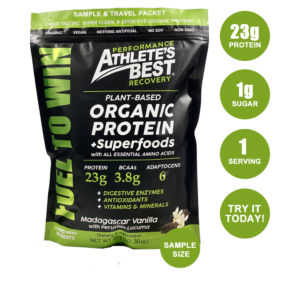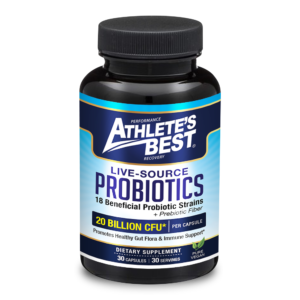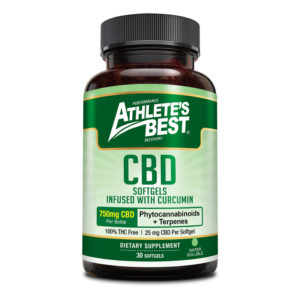6 Reasons Why We Added MSM to Our Magnesium Oil Formula for Athletes
The following studies are part of an increasing body of evidence supporting the ability of MSM to improve overall athletic performance and exercise recovery.
Supports Healthy Joints and Range of Motion
MSM is recognized for its ability to support overall joint health and a normal range of motion. In the double blinded, placebo controlled study by Linda Kim et al. (2006) results showed MSM produces a significant decrease in WOMAC pain and physical function impairment with significant improvements in the performance of daily living activities using the SF-36 evaluation(8). Additionally a study by Debbi et al. (2011) showed significant improvement in WOMAC physical function and total WOMAC score. Debbi also found VAS Pain scores had significant improvement(9). Usha et al. (2004) used VAS-pain scores and the Lequesne index as efficacy parameters with MSM showing significant improvement over placebo(10). These three studies constitute the main foundation supporting MSM’s use for maintaining healthy joints and normal range of motion.
Prevents Cartilage Breakdown
Studies also suggest MSM may support cartilage and help prevent its breakdown. Oshima et al. (2007) demonstrated MSM’s ability to reduce mRNA expression of inflammatory cytokines i.e. TNF-alpha and IL-1 in Grade II OA chondrocytes(6). In the published work of Kloesch et al. (2011) MSM dramatically down regulated expression of pro-inflammatory cytokines, IL-6 and IL-8 as well as blocking IL-1ß induced IL-6 and IL-8 expression in the human chondrocyte cell line C-28/125. Literature has documented the role of pro-inflammatory cytokines in cartilage destruction and MSM’s role in mitigating the production of these compounds may help prevent degradation of cartilage.10,11,12
Increases Overall Antioxidant Defense
Although the work of Beilke et al. (1987) suggests that MSM is not a free-radical scavenger, it appears to inhibit the oxidative function of stimulated neutrophils thus down regulating the expression of reactive nitrogen and oxygen species. This suggests an alternative explanation to an in-vivo anti-inflammatory action tied to an overall antioxidant defense(13). An equine study by Marañon et al. (2008) using jumping exercise as a stimulus showed that MSM supplementation resulted in a decrease in nitrous oxide (NO) and carbon monoxide (CO) expression and significant increase in glutathione, a very important intracellular antioxidant thiol(4). Desilvestro et al. (2008) showed MSM’s ability to increase liver glutathione levels by 78% in mice when supplemented with MSM(16). Amiroshahrokhi et al. 2011 found MSM significantly increased glutathione and significantly reduced malondialdehyde (MDA, myeloperoxidase (MPO) and pro-inflammtory marker IL-1ß in colonic tissue using a rat model of chemically induced colitis. These results add credibility to the antioxidant defense capability of MSM as it shows efficacy across different species and from different stimuli of oxidative stress. Recent Human studies also add support to MSM’s ability to increase the bodies overall antioxidant defense. Kalman et al. (2012) carried out a proof of concept study on healthy adult males. This study used two different doses of MSM results indicating that plasma trolox equivalent antioxidant capacity (TEAC) increased in a dose dependant manner. In addition homocysteine levels before treatment were either unchanged or increased slightly immediately post exercise whereas with MSM treatment homocysteine levels decreased significantly in all subjects immediately post exercise and trended towards significance in the higher dosage group(1). In Kim et al. (2008) results also indicated significant decrease in urine MDA and serum homocysteine levels in the MSM treatment group(1). Whether the role of homocysteine is causative or a result of oxidative stress is poorly understood however it is agreed that increased oxidative stress and increased homocysteine levels occur simultaneously(17), (18). Oxidized and reduced glutathione levels have been evaluated in both humans by Nakhostin-Roohi et al. (2011) and horses by Marañon et al. (2008) consistent results from both studies indicate a significant improvement in plasma antioxidant capacity. Further evidence also was shown in the double blinded, placebo controlled human study by Barmaki et al. (2012). This study showed an increase in serum total antioxidant capacity (TAC)(2) . The cumulative results of two animal studies and four human studies, three of which are double blinded placebo controlled, make a very strong case of MSM’s ability to favorably influence the body’s overall antioxidant defense capability.
Reduces Oxidative Stress Following Exercise
The Nakostin-Roohi study showed a decrease in oxidated glutathione and an increase in reduced glutathione compared to placebo following an acute bout of exercise. This suggests a reduction in oxidative stress. These results are consistent with results from the equine model used by Marañon. Oxidative stress is caused by an imbalance between the production of reactive oxygen and nitrogen species and the body’s natural ability to neutralize these radicals. This can lead to oxidative damage of cells. Measurements of specific marker compounds can be used to determine the degree of cellular damage and their components such as lipids, proteins and DNA. Malondialdehyde (MDA) is a naturally occurring product of lipid peroxidation. MDA was evaluated by Kim(2) and Nakhostin-Roohi with significant decreases seen by both for the MSM treatment group vs. placebo. Nakhostin-Roohi also measured protein carbonyls (PC) which is a marker for protein oxidative damage. Significant reduction was also seen in PC. In the study by Barmaki et al (2012) creatine kinase (CK) and lactase dihydrogenase (LDH) were measured as possible markers of oxidative damage to muscles following an acute bout of exercise. Results showed a significant reduction in these enzymes and the investigators suggest this may be due to MSM’s ability to prevent lipid per- oxidation therefore preventing leakage of CK and LDH from cell membranes thus reducing the serum concentrations.
Promotes Connective Tissue Repair and Regeneration by Decreasing Reactive Oxygen/Nitrogen Species
RONS are generally perceived as destructive in nature. However they are useful in initiating necessary inflammatory responses that lead to healing. It is important however that these free radicals are mediated so oxidative stress which may lead to hyperactive inflammatory or immune response is avoided. This may involve activation of certain transcription factors such as nuclear factor kappa B (NF-kB). Studies have shown that MSM has inhibits the activation of NF-kB and its translocation(5,6). This action may lead to maintaining adequate antioxidant status, preventing oxidative stress which that can hinder tissue repair and regeneration.
Helps Combat Exercise—Induced Inflammation & Decreases Measures of Muscle Damage and Soreness
In the recently published study by Kalman et al. (2012) a visual analog scale was used to obtain the subjects’ perception of muscle soreness at two and 48 hours post exercise, with less muscle soreness suggesting better exercise recovery. There were statistically significant increases in muscle soreness with and without product two hours post exercise (p= 0.021 and p=0.007 respectively) supporting the fact that the exercise protocol was of sufficient intensity to induce soreness. It was found that the low-dose group (1.5 grams) had a 0.5 point greater reduction in muscle soreness after supplementation with MSM than baseline, and the high-dose group (3.0 grams) had a 1.5 point greater reduction in soreness after supplementation compared to baseline. This 1.0 point difference between dosages in baseline-adjusted muscle soreness from two hours post exercise to 48 hours post exercise approached statistical significance suggesting a product dose related improvement. As mentioned previously in the study titled “Effect of methylsulfonylmethane supplementation on exercise-induced muscle damage and total antioxidant capacity” by Barmaki et al. (2012) the enzyme creatine kinase (CK) was measured. Elevated CK is indicative of trauma or skeletal muscle damage. This kind of damage or trauma would generally cause an inflammatory response and pain. Significant lower values of CK were found in the MSM group compared to placebo at 24 and 48 hrs post exercise. These results suggest that MSM may protect the muscles from damage from acute bouts of exercise and the resulting soreness or inflammation that may accompany it.
Never Leave Home Without the Ultra Pure Magnesium Oil with MSM Topical Spray
While you should already be taking 2 softgels of our Premium Omega-3 Plus daily, we literally have hundreds of athlete’s and weekend warriors take their bottle of Magnesium Oil with MSM with them on all of their workouts or athletic events. For most individuals, the product does not need to be wiped off after 20 minutes, it simply absorbs into your cells, so no need to worry about showering or washing it off. There are approximately 1,100-1,200 sprays per bottle, so don’t be shy about applying it thoroughly on your body. I personally spray a good amount after each workout, particularly on my shoulders, back, and legs, as those are areas I typically first feel the soreness after a hard workout. I can say with full confidence through my own personal use and the hundreds of testimonials I’ve received, that the product helps tremendously.
Notes:
Definition of WOMAC: The Western Ontario and McMaster Universities Arthritis Index (WOMAC) is a widely used, proprietary set of standardized questionnaires used by health professionals to evaluate the condition of patients with osteoarthritis of the knee and hip, including pain, stiffness, and physical functioning of the joints.
Definition of VAS: The Visual analog scale is a testing technique for measuring subjective or behavioral phenomena (pain) in which a subject selects from a gradient of alternatives (as from “no pain” to “worst imaginable pain”) arranged in linear fashion.
REFERENCES
- Kalman, DM et al., “Influence of methylsulfonylmethane on markers of exercise recovery and performance in healthy men: a pilot study.” J Int Soc Sports Nutr. 2012 Sep 27; 9(1):46 [Epub ahead of print]
- Barmaki, S. et al., “ Effect of methylsulfonylmethane supplementation on exercise-induced muscle damage and total antioxidant capacity.” J Sports Med Phys Fitness: 2012; April, 52(2):170-174
- Nakhostin-Roohi, B. et al., “Effect of chronic supplementation with methylsulfonylmethane on oxidative stress following acute exercise in untrained healthy men.” J Pharm Pharmacol: 2011 Oct,63(10): 1290-1294: Epub 2011, Aug 1
- Marañon, G. et al., “The effect of methyl sulphonyl methane supplementation on biomarkers of oxidative stress in sports horses following jumping exercise.” Acta Vet Scand: 2008 Nov 7;50:45
- Kloesch, B. et al., “Dimethyl sulphoxide and dimethylsulphone are potent inhibitors of IL-6 and IL-8 expression in the human chondrocyte cell line C-28/I2.” Life Sci.; 2011, Sep 26;89(13-14): 473-478. Epub 2011 July 28
- Oshima, Y. et al. “ The effect of methylsulfonylmethane (MSM) on human chondrocytes in vitro.” MOA-OARSI: 2007, Nov:213
- Usha, PR. et al., “Randomised, Double-Blind, Parallel, Placebo-Controlled Study of Oral Glucosamine, Methylsufonylmethane and their Combination in Osteoarthritis.” Clin Drug Investig. 2004; 24(6): 353-363
- Kim, LS, et al., “ Efficacy of methylsulfonylmethane (MSM) in osteoarthritis pain of the knee: a pilot clinical trial.” Osteoarthritis Cartilage. 2006 Mar,14(3):286-294 Epub 2005 Nov 23
- Debbi, EM. et al., “ Efficacy of methylsulfonylmethane supplementation on osteoarthritis of the knee: a randomized controlled study.” BMC Complement Altern Med. 2011 Jun 27; 11:50
- Lawyer, T. et al. “Cellular effects of catabolic inflammatory cytokines on chndrocytes,” Biomed Sci Inst. 2011 (47) 252-257
- Kim, J et al. “ Mitochondrial DNA damage is involved in apoptosis caused by pro-inflammatory cytokines in human OA chondrocytes.” Osteoarthritis Cartilage. 2010 Mar,18 (3):424-432: Epub 2009 Oct 1.
- Goldring, MB et al. “Roles of inflammatory and anabolic cytokines in cartilage metabolism: signals and multiple effectors converge upon MMP-13 regulation in osteoarthritis.” Eur Cells and Materials: 2011 (21): 202-220
- Bielke, MA. et al. “Effect of dimethyl sulfoxide on the oxidative function of human neutrophills.” J of Lab Clin Med. 1987 (110): 91-96
- Conner, EM. “ Inflammation, free radicals, and antioxidants.” Nutrition 1996 April 12(4): 274-277
- Sahnoun, Z. et al. “ Free radicals and antioxidants: physiology, human pathology and therapeutic aspects (part II),” Therapie, 1998 Jul-Aug; 53(4): 315-339
- DiSilvestro et al. “Methylsulfonylmethane (MSM) intake in mice produces elevated liver glutathione and partially protects against carbon-tetrachloride-induced liver injury.” FASEB Journal 2008;(22) 445.8
- Zivkovic V. “The effects of homocysteine-related compounds on cardiac contractility, coronary flow, and oxidative stress markers in isolated rat heart.” Mol Cell Biochem 2012 Nov; 370(1-2): 59-67; [Epub 2012 Jul 22]
- Aparna, P. et al. “Homocysteine and oxidative stress and inflammation in patients with coronary artery disease.” Int J Bio Med Res. 2010; 1(4): 125-129







